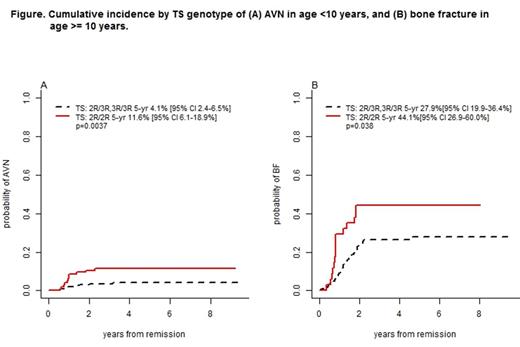Abstract
Introduction: Both fractures and avascular necrosis (AVN) of bone frequently complicate therapy for childhood acute lymphoblastic leukemia (ALL), resulting in significant pain and loss of function. Risk of bony morbidity has been associated with age >10 years and exposure to crucial components of leukemia therapy including corticosteroids, asparaginase, and methotrexate. To further define risk factors, we tested whether 19 common genetic polymorphisms were associated with bony morbidity among 637 children treated for ALL on Dana Farber Cancer Institute ALL Consortium protocol 05-001.
Methods: Genomic DNA was isolated from peripheral blood or bone marrow collected at the time of remission. Nineteen candidate polymorphisms were selected a priori, targeting common variants within genes related to glucocorticoid metabolism, oxidative damage, and folate physiology. Single nucleotide polymorphisms were detected using PCR-based allelic discrimination assays. The number of 28bp nucleotide repeats within the 5' untranslated region of the gene for thymidylate synthase (TS) was assessed by PCR-product length analysis. The incidence of AVN and fracture were estimated by the cumulative incidence method identifying death and relapse as competing risks. Because the incidence of bony morbidity differed significantly between children above and below the age of 10 years, relationships between polymorphisms and bony morbidity were explored within these two age subgroups separately. Comparisons at the 0.10 significance level were modeled univariately and were considered in multivariable modeling using competing risks regression. Multivariable models for bony morbidity included sex, WBC at diagnosis, race, final risk group, and asparaginase randomization. Blood was collected during treatment for analysis of serum and RBC folate by HPLC.
Results: Of the 637 patients tested, 627 achieved a complete remission and received post-induction therapy, of which 61 (9.7%) experienced AVN and 138 (22.0%) had ≥1 fracture. Both AVN and fracture were more common among those ≥10 years of age (22.9% AVN, 30.7% fracture) than younger children (5.5% AVN, p<0.0001 and 19.2% fracture, p=0.002). Homozygosity for the 2R TS polymorphism was observed in 129 (20.6%) of the 626 patients tested. This 2R/2R genotype was associated with a greater 5-year estimated incidence of AVN (11.6%; 95% CI 6.1-18.9%) than among those with 2R/3R or 3R/3R genotypes (4.1%, 95% CI 2.4-6.5%; p=0.0037; Figure [A]) among children < age 10, but not among older children. The increased risk of AVN in younger children remained significant in the multivariable risk regression model (adjusted hazard ratio 2.92; 95% CI 1.36-6.28; p=0.0059). Among children over age 10, this polymorphism was associated with an increased risk of bony fracture (multivariable HR 2.13; 95% CI 1.13-3.99; p=0.019; Figure [B]). No significant association was observed between bony morbidity and the other tested polymorphisms, including PAI-1 (rs6092), ABCB1 (rs1045642), and the vitamin D receptor Fok1 restriction site (rs228570) which have been previously linked to risk of AVN. Samples were available for analysis of serum and RBC folate at diagnosis (n=367), remission (n=347), 15 months post-remission (n=251), and at the conclusion of therapy (n=247). No significant association was observed between TS genotype and serum or RBC folate at any time point.
Conclusions: Homozygosity for the 2R polymorphism in TS was associated with increased risk of bony morbidity among children treated for ALL. Interestingly, the impact of the polymorphism differed between those above the age of 10 years (associated with risk of fracture) and younger children (risk for AVN), suggesting that the pathophysiology of bony morbidity differs between these two age groups. This is the first report identifying a genetic risk factor for AVN specifically among children younger than 10 years, a group where AVN is significantly less frequent. This result suggests young children with ALL and the 2R/2R genotype should be monitored more closely for the development of AVN during therapy for ALL.
Silverman:Seattle Genetics, Inc.: Research Funding.
Author notes
Asterisk with author names denotes non-ASH members.


This feature is available to Subscribers Only
Sign In or Create an Account Close Modal